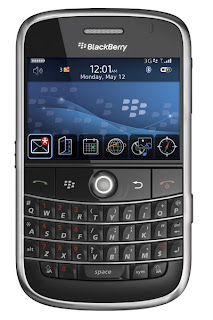search
The new BlackBerry Curve 8900, as well as being an exceptional phone with email, messaging, organizer, web browser and multimedia applications, also features built-in Wi-Fi®, GPS including BlackBerry® Maps, a fast processor and a dazzling hi-resolution display that gives users an enjoyable and exceptional communications experience.
The stylish new BlackBerry Curve 8900 has a full featured media player that supports media streaming and can play all your favourite songs and videos. With a 3.2 megapixel camera, auto focus, digital zoom and flash, you can take sharp, print quality pictures that you can send straight to friends or post directly onto the Internet.
The Bold features a HVGA (480 x 320 pixels) resolution display, the same found in the Apple iPhone, which will most likely improve usability of many of the BlackBerry applications. And to answer your next question, no, it's not touchscreen.
RIM packed in 1 GB of internal memory into the Bold 9000, as well as a microSD card slot for up to 16 GB of extra memory. Connectivity wise, the BlackBerry Bold contains tri-band HSDPA and quad-band EDGE, 802.11a/b/g Wi-Fi, stereo Bluetooth and GPS.
Other features include a 2 megapixel camera with 5x digital zoom, improved QWERTY keyboard with thin metal strips between each row and a 3.5mm headphone jack. All this running on a 624MHz StrongARM processor with full MMX, the fastest CPU that can be found on a handset.

Status: Available.Dimensions: 112 x 62 x 14.2 mmWeight: 130 gColor Depth: 65K colors
Available Color(s): Black
Camera: 3.15 MP, 2048×1536 pixels, autofocus, LED flash
Call records: YesSpeakerphone: YesRingtone Type: PolyphonicVibrate: Yes
internal Memory: 256 MB
External Memory: microSD (TransFlash), microSDHC, up to 8 GB
Other Features:Messaging: SMS, MMS, Email, IM
Operating System: BlackBerry OSBrowser: Yes, HTML
Radio: NoBluetooth: Yes, v2.0 with A2DPHSCSD: Yes
3G: Yes- Voice memoHardware Specifications: Battery Standard battery, Li-Ion 1400 mAh
Type: Li-IonStand-by Time: Up to 336 hrsTalk Time: Up to 5 hrs

Size
Dimensions112.5 x 62.2 x 14 mm
Weight155 g
DisplayType
TFT capacitive touchscreen, 65K colors
Size360 x 480 pixels, 3.25 inches
- Accelerometer sensor for auto-rotate
SoundVibration, MP3 ringtones
Speakerphone Yes
3.5 mm audio jack
Memory
Phonebook
Practically unlimited entries and fields, Photocall
Internal1 GB storage, 128 MB RAM, 192 MB ROM
Card slotmicroSD, up to 16GB, 8GB card included, buy memory
Class 10, 236.8 kbps
3G
HSDPA, 7.2 Mbps
WLANNo
BluetoothYes, v2.0 with A2DP
microUSB v2.0
Camera3.15 MP, 2048x1536 pixels, autofocus, LED flash
- BlackBerry maps - Document editor (Word, Excel, PowerPoint, PDF)- MP3/WMA/eAAC+ player- MP4/H.264/H.263/WMV player- Organizer- Voice dial/memo

+ Early Pager Models: 850, 857, 950, 957
+ Monochrome Java-based Models. 5000-series and 6000-series
+ First Color Models: 7200-series, 7500-series and 7700-series
+ First SureType Phone Models: 7100-series
+ Modern BlackBerry Models (2006 - 2008). 8000-8830-series including: BB8800, BlackBerry Pearl, Pearl Flip and BlackBerry Curve
+ Latest BlackBerry Models (2008 - 2009): 8900+ GPS WiFi Series: BlackBerry Bold (9000), BlackBerry Curve 8900, BlackBerry Tour (9630), BlackBerry Storm (9500/9530)
+ BlackBerry Storm 2 (2009). BlackBerry Storm 2 [12]
+ BlackBerry Bold 2 (2009). BlackBerry 9700 (9700 / Bold 2) [13]
In 2002, the more commonly known smartphone BlackBerry was released, which supports push e-mail, mobile telephone, text messaging, internet faxing, web browsing and other wireless information services.BlackBerry is a line of wireless mobile device that was introduced in 1999 as a two-way pager. It is an example of a convergent device. BlackBerry first made headway in the marketplace by concentrating on e-mail. RIM currently offers BlackBerry e-mail service to non-BlackBerry devices, such as the Palm Treo, through the BlackBerry Connect software. The original BlackBerry device had a monochrome display, but all current models have color displays, and are market leaders in innovation, specifically surrounding multi-tasking operating systems and integration with backend messaging and collaboration and customised application systems.









